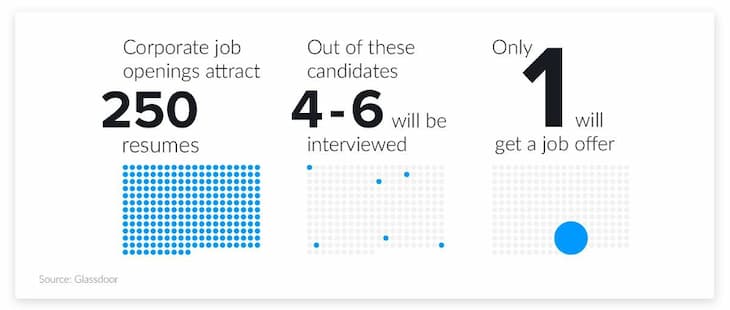If we ask you how you will screen the qualified candidates out of the total number of candidates who applied for your ideal role, the first method that will come to mind will be resume screening.
Now that you have posted your job description on job posting sites like Indeed, Linkedin, Glassdoor, etc., you must be ready to experience hundreds, if not thousands, of applications coming in. You can get excited about the number of applications until you sit back and think that someone has to look at all of them and find the best candidate for the job.
Filtering the unqualified and finding all-star-performing candidates among all applicants can be challenging. So how can you know whether a candidate is a good fit for the position, team, and the company?
Therefore, even your resume screening needs to be effective, and we will discuss it right here — the tips that will make your resume screening better.
Tips for Effective Resume Screening?
The results are detrimental without a systematic resume screening process, especially for high-volume recruiters. According to Glassdoor, each job post attracts 250 resumes, and if your strategy isn’t practical, you are more prone to bad hires, financial stress, and loss of time as an employer.
To avoid such potential risks and make your screening effective, here are the eight tips we suggest.
Perform Job Analysis to Identify Clear Criteria
Before you start reviewing resumes, you should first identify specific criteria for the job. Having a consistent strategy for identifying these criteria can help make the process more efficient.
A job analysis can help you identify the essential skills, knowledge, and abilities (KSAs) for each role, which ultimately makes resume screening easier. Moreover, you can add the required years of experience and education level to the criteria. It provides a more accurate and complete understanding of the position.
Ensure your Job Posting is attracting the Right Applicant

Your job post will attract numerous applicants, but only a handful of them will be suitable for the role. According to Glassdoor, out of 25 job applications an average job posting attracts, 4-6 of them will get qualified for an interview.
Therefore, you must outline more than just years of experience, educational & certification requirements, and technology buzzwords in your posting.
Be specific about your ideal applicant’s track record and achievements and add them to your job analysis criteria.
Focus on Geographical Suitability
In recruitment, one of the main reasons a candidate may turn down a role or accept a counter-offer is the location and commute time. Therefore, it is imperative to ensure that this step matters to the candidate in the long run, and as nothing will leave you with a short drive to work, so start your selection process by checking the candidate’s address if they have it included.
Unfortunately, many job seekers go on an application spree and submit CVs for any role that appears to be broad in their location, so limit your initial selection to candidates within a commutable radius of your company’s physical location to save yours as well as your candidate’s time. However, a good candidate understands this, and therefore, a great resume will clearly show their geographical suitability.
Sort the Resumes with Identified Criteria

Once you have your selection criteria ready, you can start sorting the resumes that match the criteria. These may often include:
- Years of experience – usually in a similar or relevant role
- Qualification – such as degree or certificate
- Capabilities, skills, and competencies – such as the ability to code in a web programming designation
- Personality Traits – A common is looking for hiring managers to pay attention to detail or organized
When screening for the minimum criteria, you scan the resume and remove any job aspirants who do not meet the demands. Moreover, sticking to defined parameters to look for can make your screening effective.
Identify your Business Needs
Whether you have to fill an existing vacancy or a completely new position, the key to effective screening is to analyze the company’s specific needs.
It may seem like an obvious tactic, but we often see clients who advertise a role, receive a lot of applications, and then at the end of the campaign realize that they don’t know what they want in their new employee/s.
You must do your homework first to enable a brief shortlist of qualified candidates at the end of your process. Ensure you understand what type of person your organization needs and what you want to do before hiring the candidate.
Keep Everything Ready
Before going through the CV, you should have a few things ready in front of you.
- Job Description: Put it in front of you on a piece of paper or the screen. It needs to be visible somewhere to refer to it during the screening process.
- Must-Have Skills: Make a shortlist of the candidates’ skills. It will help you to screen out those without these skills. Remember, list only those skills that are essential, without exception.
- Must-Have Experience: Whether it is experience managing a team, or three years of experience developing dev apps, make a list of experiences the candidate must have.
- Benefits: List the skills, experiences, and other beneficial factors for the more advanced and effective screening phase.
Utilize an ATS
Studies report that at least half of job seekers do not have the basic qualifications for the jobs they are applying for. With the help of an ATS or applicant tracking system, employers can filter out candidates whose experience and skills do not match the job requirements. If the CV does not include the correct keywords or does not correspond to the position candidates are applying for, it will probably never come into the hands of the employers.
Hirebeat can cut the hiring cycle process time by more than 80% and save 50% on hiring costs.
Follow the Standardization
Do all recruiters have the same screening capabilities? To ensure that each resume is evaluated equally, create a standard screening system that can be implemented throughout the hiring and recruitment department. However, standardizing the screening process requires a great deal of organization, especially if it is completed manually. To achieve this, hiring teams need to follow the same methodology for screening candidates evenly.
It can be accomplished in various stages:
Step 1: The candidate must meet the basic requirements, i.e., job titles that equally reflect the role they are applying for (reflecting the required industry experience).
Step 2: Note down the details of their skills and their experience. Could it transfer well over the new role?
Final Stage: Qualification and Timeline. During this stage, if there are many candidates left, you can afford to be picky. Look at their qualifications and length of experience as determining factors.
By following this guide to effective resume screening, you can save yourself a lot of time and hassle in screening resumes. In addition, you can use the latest technologies like Hirebeat to get things done faster!
Hirebeat is a one-stop source of solutions to all your recruiting challenges. It ensures everything around your recruiting, from marketing your ideal job role/s to analyzing the applicant’s resumes and video interviews (through AI).







